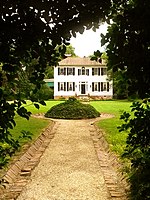Legacy Early College Field
Buildings and structures in Greenville County, South CarolinaGreenville Triumph SCSoccer venues in South CarolinaSouth Carolina building and structure stubsSouth Carolina sport stubs ... and 3 more
Southern United States sports venue stubsSports venues in Greenville, South CarolinaUSL League One stadiums
Legacy Early College Field is a 4,000-seat stadium located on the campus of Legacy Early College, a college preparatory school, in Greenville, South Carolina. The stadium is best known for being the home field for Greenville Triumph SC, a professional soccer club that plays in USL League One, the third tier of soccer in the United States.
Excerpt from the Wikipedia article Legacy Early College Field (License: CC BY-SA 3.0, Authors).Legacy Early College Field
East Bramlett Road, Greenville
Geographical coordinates (GPS) Address Nearby Places Show on map
Geographical coordinates (GPS)
| Latitude | Longitude |
|---|---|
| N 34.859050536983 ° | E -82.425142691268 ° |
Address
East Bramlett Road
29611 Greenville
South Carolina, United States
Open on Google Maps






